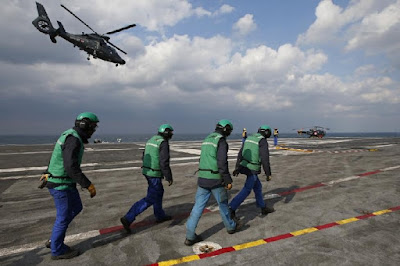Charles de Gaulle is the flagship of the French Navy (Marine Nationale) and the largest western European warship currently in commission. She is the tenth French aircraft carrier, the first French nuclear-powered surface vessel, and the first and so far only nuclear-powered carrier completed outside of the United States Navy. She is named after French statesman and general Charles de Gaulle.
The ship carries a complement of Dassault-Breguet Super Étendard, Dassault Rafale M and E‑2C Hawkeye aircraft, EC725 Caracal and AS532 Cougar helicopter for combat search and rescue, as well as modern electronics and Aster missiles. She is a CATOBAR-type carrier that uses two 75 m C13‑3 steam catapults of a shorter version of the catapult system installed on the U.S. Nimitz-class aircraft carriers, one catapult at the bow and one across the front of the landing area. Thanks to her characteristics, Charles de Gaulle is the only non-American carrier-vessel in the world able to operate American aircraft such as the F/A-18E/F Super Hornet or C-2 Greyhound, which operate from American carrier-vessels.
Construction
The carrier replaced Foch, a conventionally powered aircraft carrier, in 2001. Clemenceau and Foch were completed in 1961 and 1963 respectively; the requirement for a replacement was identified in the mid-1970s.
The hull was laid down in April 1989 at the DCNS Brest naval shipyard. The carrier was launched in May 1994 and at 35,500 tonnes was the largest warship launched in Western Europe since HMS Ark Royal in 1950. She was to be named Richelieu in 1986 by the French president at the time, François Mitterrand, after the famous French politician Armand-Jean du Plessis, Cardinal or the Duc de Richelieu. On 7 February 1987. However, the name of the ship was changed to Charles de Gaulle by the Gaullist Prime Minister at the time, Jacques Chirac.
Construction quickly fell behind schedule as the project was starved of funding, which was worsened by the economic recession in the early 1990s. Total costs for the vessel would top €3 billion. Work on the ship was suspended altogether on four occasions: 1990, 1991, 1993, and 1995. The ship was commissioned on 18 May 2001, five years behind the projected deadline.
In 1993, it was alleged by The Guardian that a group of engineers inspecting the vessel during her construction were British Secret Intelligence Service (MI6) operatives, believed to have been learning the method of shielding the nuclear reactors, amongst other technical details. However, the newspaper published a denial by both the British government and the Direction de la surveillance du territoire (DST) (in English: Directorate of Territorial Surveillance) that there had been any incident.
On 16 September 2001 the French press reported slightly higher than acceptable radioactivity levels aboard Charles de Gaulle, thought to be caused by a faulty isolation element. It was later discovered that the radioactivity levels matched the design, but that the regulations concerning acceptable radioactivity levels had changed. While the United States was preparing its response to the September 11 attacks in the form of Operation Enduring Freedom, French media complained about the lack of deployable French military power. At the same time, the Defence Commission reported the maintenance of the Fleet to be substandard. In this context, Charles de Gaulle, then under repairs, was again an object of criticism, with former President Valéry Giscard d'Estaing describing it as a "half-aircraft-carrier" and requesting launching of the second carrier vessel (named PA2) in order to guarantee an availability rate of 100%.

































